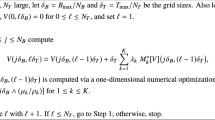Abstract
Budget optimization (selecting an optimal set of keywords to bid for, given a limited amount of budget) and bid optimization (determining optimal bids for the selected keywords) in the face of an unpredictable keyword traffic is a challenging problem facing advertisers in sponsored search auctions. Another key requirement in sponsored search auctions is stability of the bid profile, which is usually characterized through the notion of locally envy-free equilibrium. A variety of budget optimization and bid optimization ideas have been proposed in the literature; the bid profiles suggested by them have varying stability properties. In this paper, our objective is to come up with a bidding strategy for advertisers that is optimal for the budget optimization as well as the bid optimization problems and also guarantees convergence to a locally envy-free equilibrium. Our approach works with a linear program for the budget optimization problem whose optimal solution is a greedy strategy, which we call the OPT strategy. The OPT strategy yields a bid profile that maximizes the return on investment for the advertisers and ensures convergence of the bid profiles to a locally envy-free equilibrium in the asynchronous case as well as in a restricted synchronous case. We also suggest an improved strategy called the MAX strategy which produces equal or higher advertiser utilities compared to the OPT strategy while enjoying identical equilibrium convergence properties as OPT.


Similar content being viewed by others
References
Abrams Z, Mendelevitch O, Tomlin J (2007) Optimal delivery of sponsored search advertisements subject to budget constraints. In: Proceedings of the 8th ACM conference on electronic commerce, pp 272–278
Archak N, Mirrokni VS, Muthukrishnan S (2010) Budget optimization for online advertising campaigns with carryover effects. In: 6th workshop on Ad auctions
Asdemir K (2006) Dynamics of bidding in search engine auctions: An analytical investigation. In: Proceedings of the Second workshop on sponsored search auctions, ACM Conference on Electronic Commerce
Auerbach J, Galenson J, Sundararajan M (2008) An empirical analysis of return on investment maximization in sponsored search auctions. In: ADKDD ’08: proceedings of the 2nd international workshop on data mining and audience intelligence for advertising, pp 1–9
Borgs C, Chayes J, Etesami O, Immorlica N, Jain K, Mahdian M (2007) Dynamics of bid optimization in online advertisements. In: Proceedings of the 16th international conference on World Wide Web (WWW-2007), pp 531–540
Cary M, Das A, Edelman B, Giotis I, Heimerl K, Karlin AR, Mathieu C, Schwarz M (2007) Greedy bidding strategies for keyword auctions. In: Proceedings of the 8th ACM conference on electronic commerce, pp 262–271
Cormen TH, Leiserson CE, Rivest RL (1990) Introduction to algorithms. MIT Press, Cambridge; MA/McGraw-Hill, New York
Dar EE, Mirrokni VS, Muthukrishnan S, Mansour Y, Nadav U (2009) Bid optimization for broad match Ad auctions. In: Proceedings of the 18th international conference on World Wide Web (WWW-2009)
Edelman B, Ostrovsky M (2005) Strategic bidder behavior in sponsored search auctions. In: First workshop on sponsored search auctions, ACM Electronic Commerce
Edelman B, Ostrovsky M, Schwarz M (2006) Internet advertising and the generalized second price auction: selling billions of dollars worth of keywords. In: Proceedings of the second workshop on sponsored search auctions, ACM conference on electronic commerce
Feldman J, Muthukrishnan S, Pal M, Stein C (2007) Budget optimization in search-based advertising auctions. In: Proceedings of the 8th ACM conference on electronic commerce, pp 40–49.
Feng J, Bhargava HK, Pennock DM (2007) Implementing sponsored search in web search engines: computational evaluation of alternative mechanisms. INFORMS J Comput 137–148
Hafalir I, Ravi R, Sayedi A (2009) Sort-cut: a pareto optimal and semi-truthful mechanism for multi-unit auctions with budget-constrained bidders. In: 5th workshop on ad auctions
Hashimoto T (2010) Equilibrium selection, inefficiency, and instability in internet advertising auctions. In: 6th workshop on Ad auctions
Mahdian M, Nazerzadeh H, Saberi A (2007) Allocating online advertisement space with unreliable estimates. In: Proceedings of 8th ACM conference on electronic commerce, pp 288–294
Mehta A, Saberi A, Vazirani U, Vazirani V (2005) Adwords and the generalized bipartite matching problem. In: Proceedings of the symposium on the foundations of computer science, pp 264–273
Milgrom P (2007) Simplified mechanisms with applications to sponsored search auctions. Levine’s bibliography. UCLA Department of Economics
Muthukrishnan S, Pal M, Svitkina Z (2007) Stochastic models for budget optimization in search based advertising. In: Proceedings of workshop on internet and network economics WINE’07, pp 131–142
Nisan N, Roughgarden T, Tardos E, Vazirani VV (2007) Algorithmic game theory. Cambridge University Press, Cambridge
Rusmevichientong P, Williamson DP (2006) An adaptive algorithm for selecting profitable keywords for search-based advertising services. In: Proceedings of the 7th ACM conference on electronic commerce, pp 260–269
Varian HR (2007) Position auctions. Int J Ind Organ 25:1163–1178
Zhou Y, Chakrabarty D, Lukose R (2008) Budget constrained bidding in keyword auctions and online knapsack problems. Internet Netw Econ 5385:566–576
Author information
Authors and Affiliations
Corresponding author
Appendix
Appendix
1.1 Proof of Theorem 3
Proof
To prove this result, we first bound the number of steps until the price of slot k and the set of players who will be allocated slots have converged. We define \( \gamma_j = \theta_j / \theta_{j-1} \). At time t, we say that a player p is activated if p is the player who updates her bid while the other bidders repeat their previous bids.\(\square\)
Lemma 4
Player p prefers to target slot j rather than slot (j − 1) if \( p_{j-1} \geq (1-\gamma_j)v_p + \gamma_jp_j \). Moreover,
Proof
By definition, \(j \in \substack{argmax l \in [1 ,\, k]} \left( \theta_l (v_p - p_l) \right) \). Hence we have:
From Eq. (12), we have:
Rearranging the terms in this equation gives us that:
Also,
Hence we have
Hence proved.\(\square\)
Lemma 5
After t rounds, we have:
where \(\gamma^* = \max_{i>0} \theta_i/\theta_{i-1}, t > t_1 = 2 + \log_{\gamma^*}((1-\gamma^*)(v_k - v_{k+1}))\)
Proof
Let the (k + 1)st highest bid be \(b \leq v_{k+1}\). In some round, consider any player i in \(\lbrace 1,2, \ldots , (k+1) \rbrace\). In the next round, i will either bid her value or target some slot \(j \in \lbrace 1,2, \ldots , k \rbrace\) and bid \(b_i^{'} \geq p_k \geq (1-\gamma^*)v_{k+1}+\gamma^* b \geq b + (1-\gamma^*)(v_{k+1}-b)\). In either case,
Initially \(v_{k+1} - b \leq v_{k+1} \). By round \(r \leq \log_{\gamma^*}((1- \gamma^*)(v_k- v_{k+1})/v_{k+1} )\), we have \(v_{k+1} - b < (1-\gamma^*)(v_k - v_{k+1})\). Hence by round (r + 1), bidders \(i \in \lbrace 1, \ldots , k \rbrace\) will each bid either \(v_i > v_{k+1} \) or bid at least
hence in either case their bids are above v k+1. From (r + 2) onwards, player k + 1 will then bid v k+1 while players 1, 2, …, k continue to bid above v k+1; the other players don’t get a slot, so they bid their value, and this concludes the proof.
We now need to prove that the allocation of the k slots to these k players converges to its fixed point. At any time, for any i ∈ [1, k], consider the players allocated slots [i + 1, k]. We call them stable if the allocation is in order of decreasing valuations. If the players allocated to all slots [1 , k] form a stable set, then we have reached the fixed point.
Assume that the current setting is not (yet) assortative. Let A be the maximum stable set, with associated \(i \geq 2 \), and let B be the set of players in slots [1, i]. Let b min denote the minimum bid from players of B.
We define a partial order over sets of players. We say that \(A^{'} \succ A\) if either \(A \subset A^{'}\) and A ≠ A′, or if the player of minimum value in the symmetric difference of A and A′ belongs to A′ (This corresponds to a lexicographic ordering of the sets). This will be our measure of progress.
In the next round, observe that, following the MAX strategy, players in A still bid in the same way as before. Let b′ min be the new minimum bid from players of B, and p be the player of B whose bid is b′ min . Let us consider the possible three cases:
-
1.
p targets some slot j ∈ [i + 1, k] in A. Let j ∈ [i + 1, k] be the slot targeted by p. By lemma 4, we have \(b_j \in (p_{j-1},\, p_j)\). and p will be allocated slot j. Recall that π(j) denotes the player who was in slot j in the previous round. We now claim that
Lemma 6
\(v_p < v_{\pi(j)}\)
Proof
From lemma 4, we have \(p_{j-1} > b_p \geq {\frac{v_{p}} {1+\gamma_j ({\frac{v_{p}} {p_{j}}} -1) }}.\)
Hence proved. \(\square\)
Lemma 7
\(v_p > v_{\pi(j+1)}\)
Proof
From Lemma 4 we have \(b_p > p_j = b_{j+1}\)
Lemma 6 and Lemma 7 prove the assortative criterion. Hence, we have, \(A^{'} = \lbrace p' \in A : v_{p'} \rbrace \cup \lbrace p \rbrace\) is a stable set, and \(A' \succ A\).
-
2.
p targeted slot i. From Lemma 4, \(b_p \in (p_j, \, p_{j-1})\) and thus is allocated slot i. Now, \(A' = A \cup \lbrace p \rbrace\) is a stable set using lemmas 6 and 7 again and \(A' \succ A\).
-
3.
p targeted some slot \(j \leq i-1\). Then A is still a stable set, and \(b_{{\rm min}} = p_{i-1}\) has increased:
$$ \begin{aligned} b'_{{\rm min}} &\geq p_k \geq (1-\gamma^*)v_{k+1} + \gamma^*b_{{\rm min}}\\ & = b_{{\rm min}} + (1-\gamma^*)(v_{k+1} - b_{{\rm min}}) \cr \end{aligned} $$
We will prove that Case 3 can only happen a bounded number x of times, before Case 1 or Case 2 must occur. Thus, the maximum stable set A must change at least once every x rounds, and when that happens, it is replaced by a set A′ such that \(A' \succ A\). This implies that the system converges to a fixed point and that the number of rounds until convergence is bounded by 2k(x + 1), hence the Theorem. \(\square\)
Lemma 8
Let \(\varepsilon = {\frac{\theta_k(1-\gamma^*) \min_{q \neq q'} \mid v_q - v_{q'} \mid} { 2\theta_1(1 + \gamma^*(\xi^* - 1))}} \) . If \(p_{i-1} > v_p - \varepsilon\) and \(v_p > p_i \) , then player p prefers to target slot i to any slot j < i.
Proof
From player p’s viewpoint, the utility of slot i is \(\theta_i(v_p - p_i)\), the utility of slot j < i is \(\theta_j(v_p - p_j) < \theta_j(v_p - p_{i-1}) \), and the ratio is
We define \(\xi^* = {\frac{v_1} {v_{k+1}}} \). Now,
Now, let \(x = \log_{{\frac{1} {\gamma^*}}} ((v_1 - v_{k+1})/\varepsilon)\). Assume that Case 3 happens for x consecutive rounds. Let \(p_{{\rm min}}\) be the player in B whose value is minimum and \(v_{{\rm min}}\) be its value. Let \(b^{(t)}_{{\rm min}}\) be the minimum bid of players in B after t rounds, \(0 \leq t \leq x\). If p ∈ B is the player defining the minimum bid in round t + 1, we have:
After x rounds, we get \(b^{(x)}_{{\rm min}} \geq v_{{\rm min}} - (\gamma^*)^x(v_{{\rm min}} - b^{(0)}_{{\rm min}})\), hence \(b^{(x)}_{{\rm min}} \geq v_{{\rm min}} - (\gamma^*)^x(v_i - v_{k+1})\). Substituting the value of x yields \(b^{(x)}_{{\rm min}} \geq v_{{\rm min}} - \varepsilon\). From Lemma 8, we know that \(p_{{\rm min}}\) prefers slot i to any slot j < i. In the next round \(p_{{\rm min}}\) targets slot i and has to be the minimum bidder from B, therefore we are now in Case 2. Thus there are at most x occurrences of Case 3 between any two occurrences of Case 1 or Case 2, and the Theorem is proved.\(\square\)
Rights and permissions
About this article
Cite this article
Chaitanya, N., Narahari, Y. Optimal equilibrium bidding strategies for budget constrained bidders in sponsored search auctions. Oper Res Int J 12, 317–343 (2012). https://doi.org/10.1007/s12351-010-0097-8
Received:
Revised:
Accepted:
Published:
Issue Date:
DOI: https://doi.org/10.1007/s12351-010-0097-8




